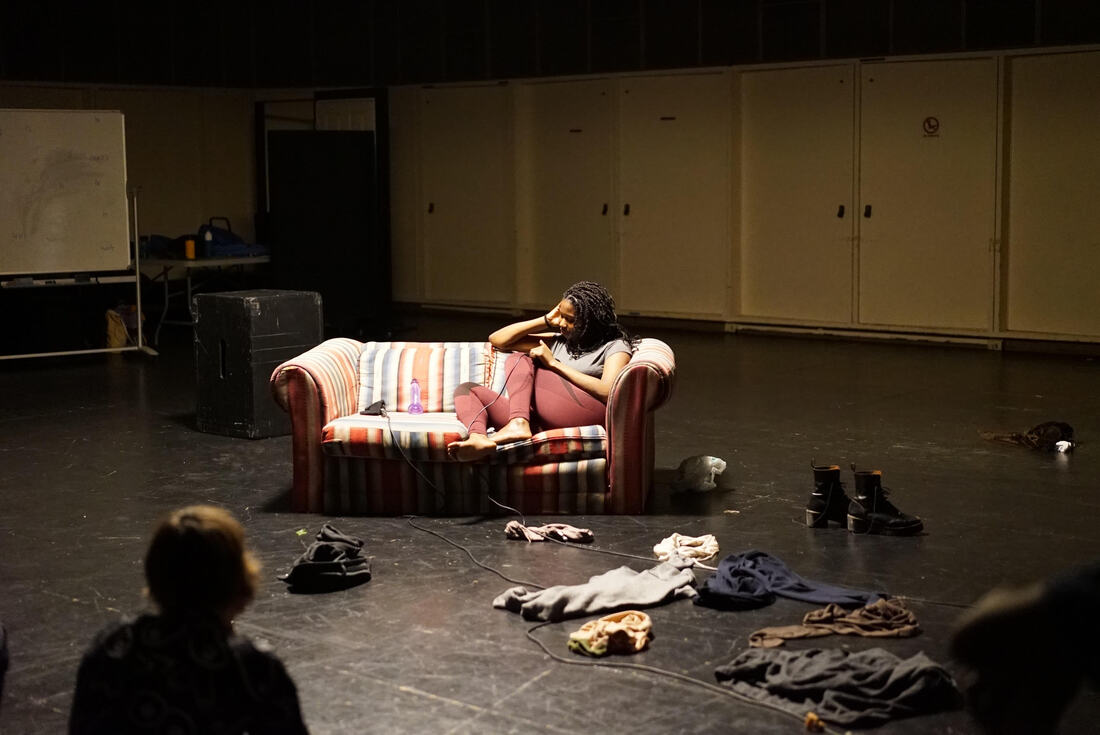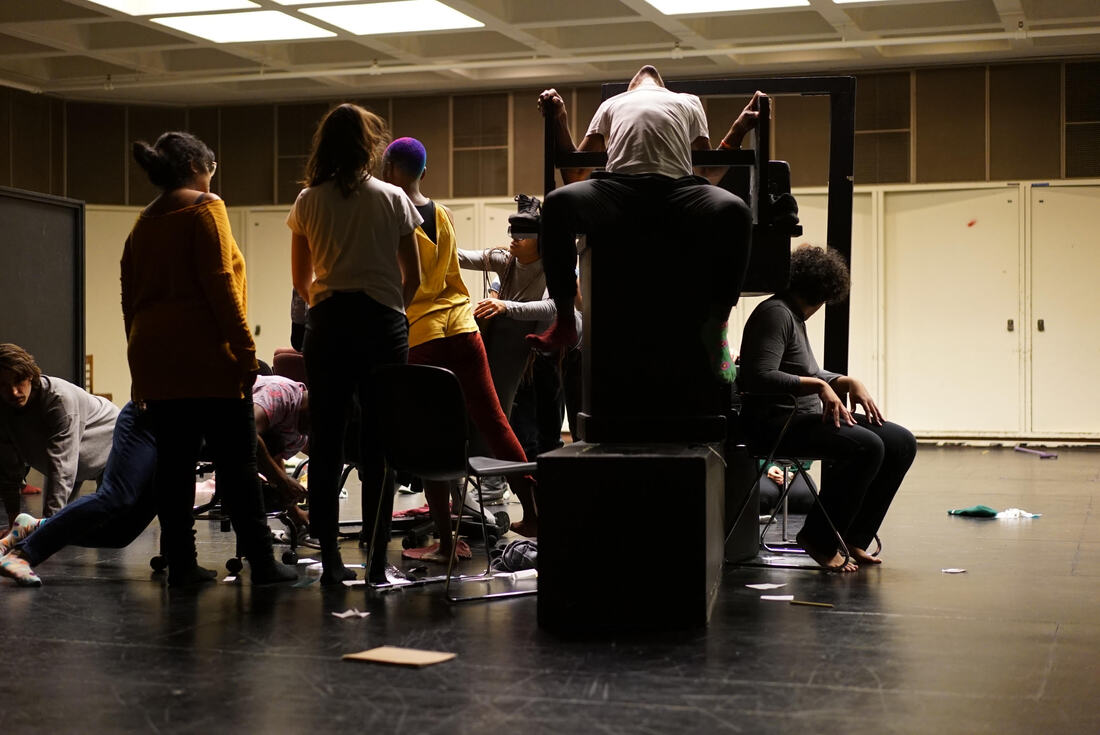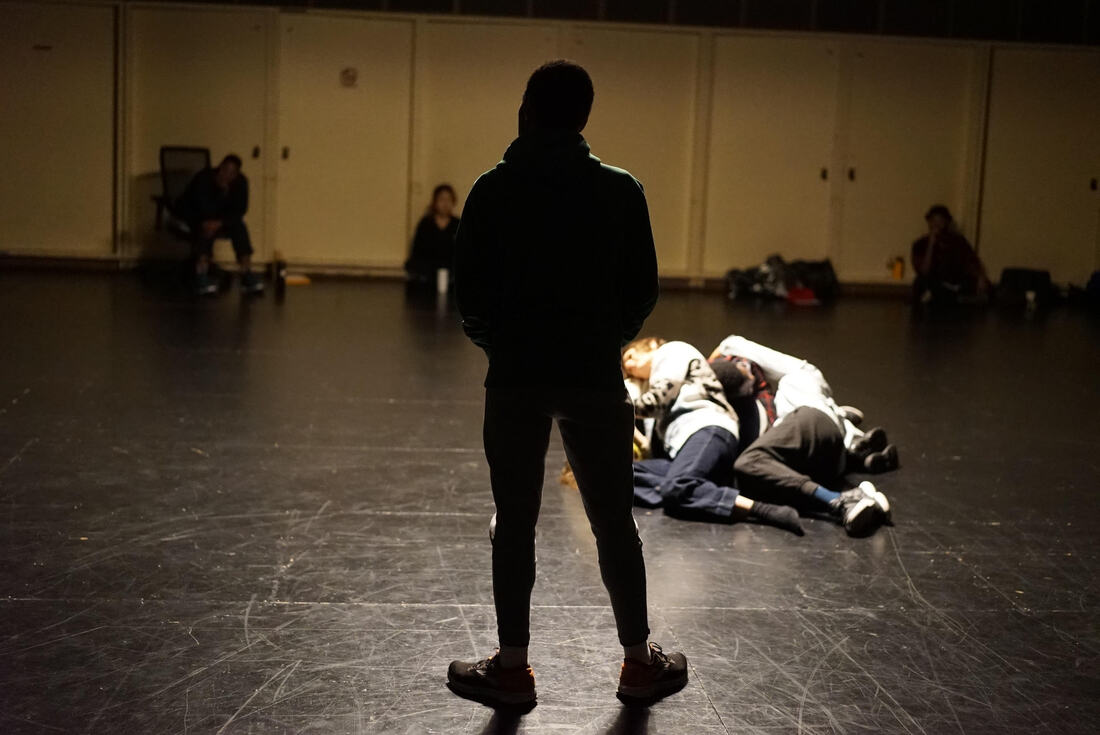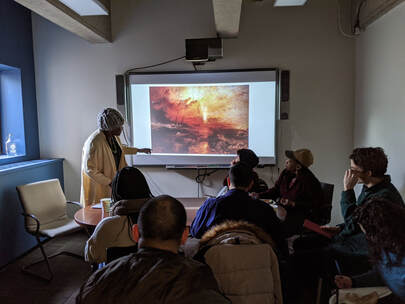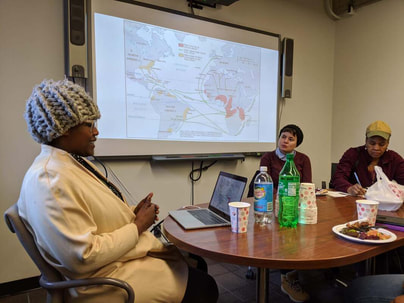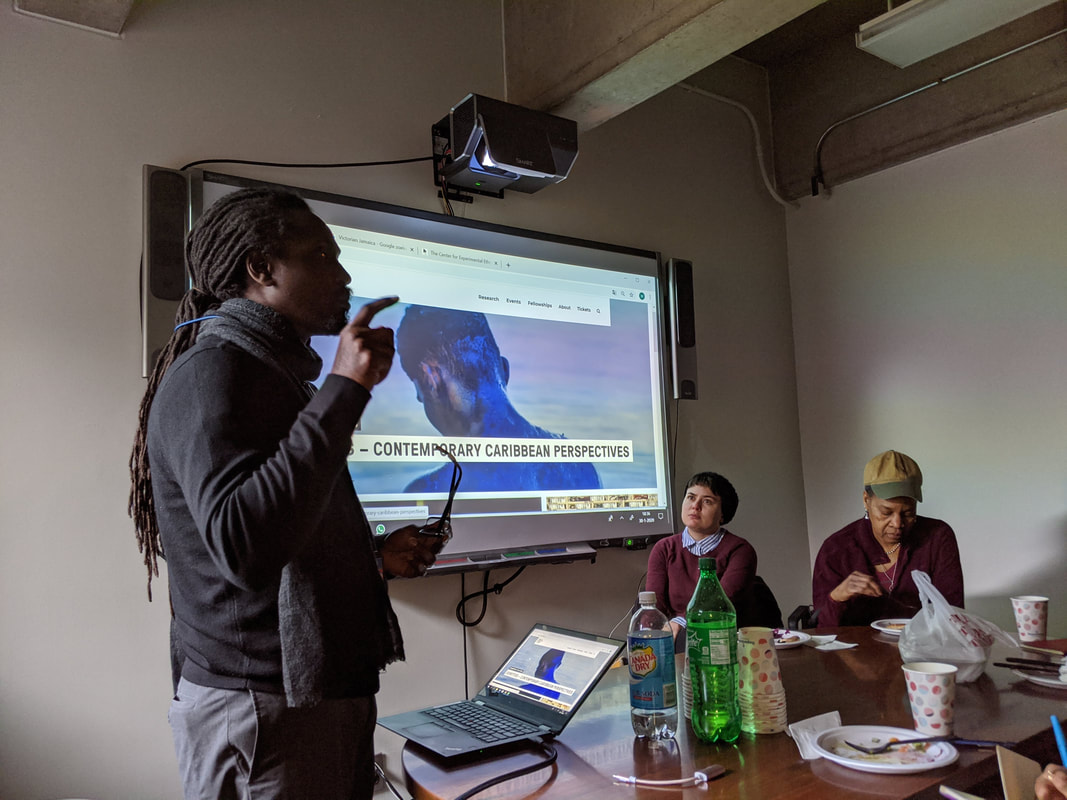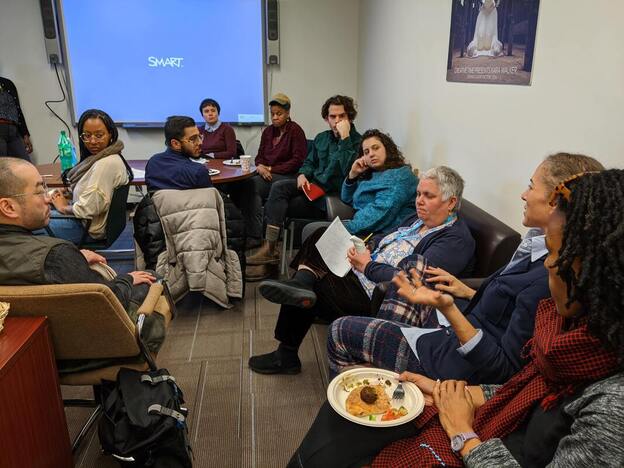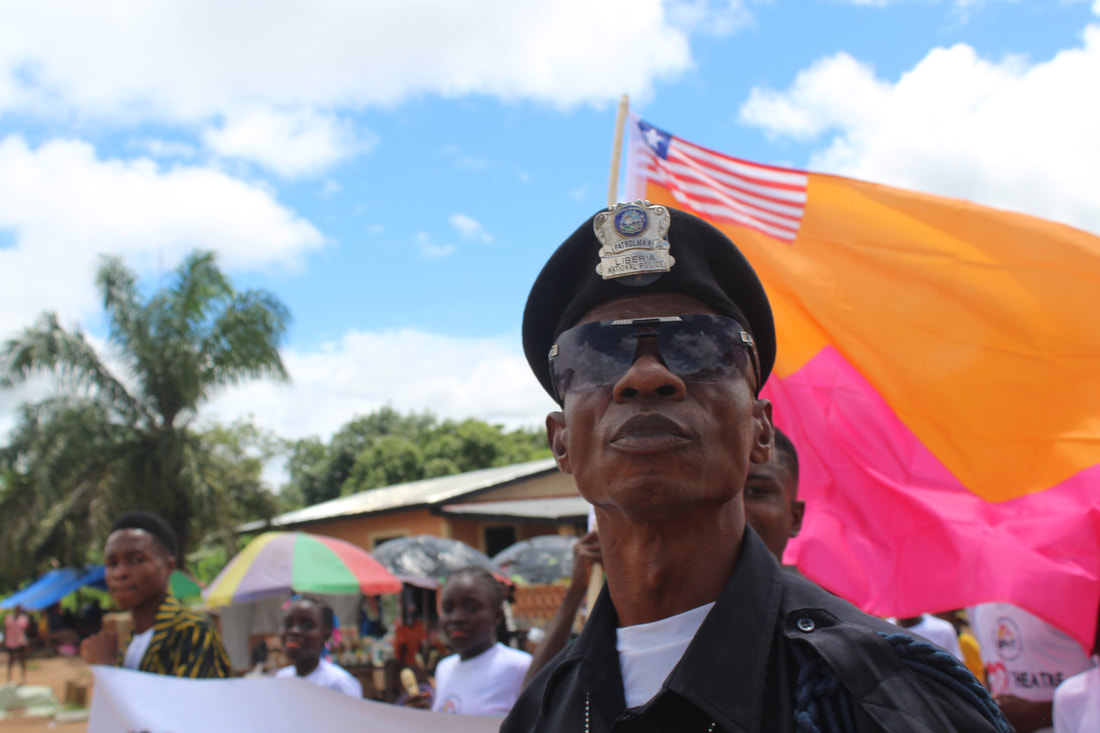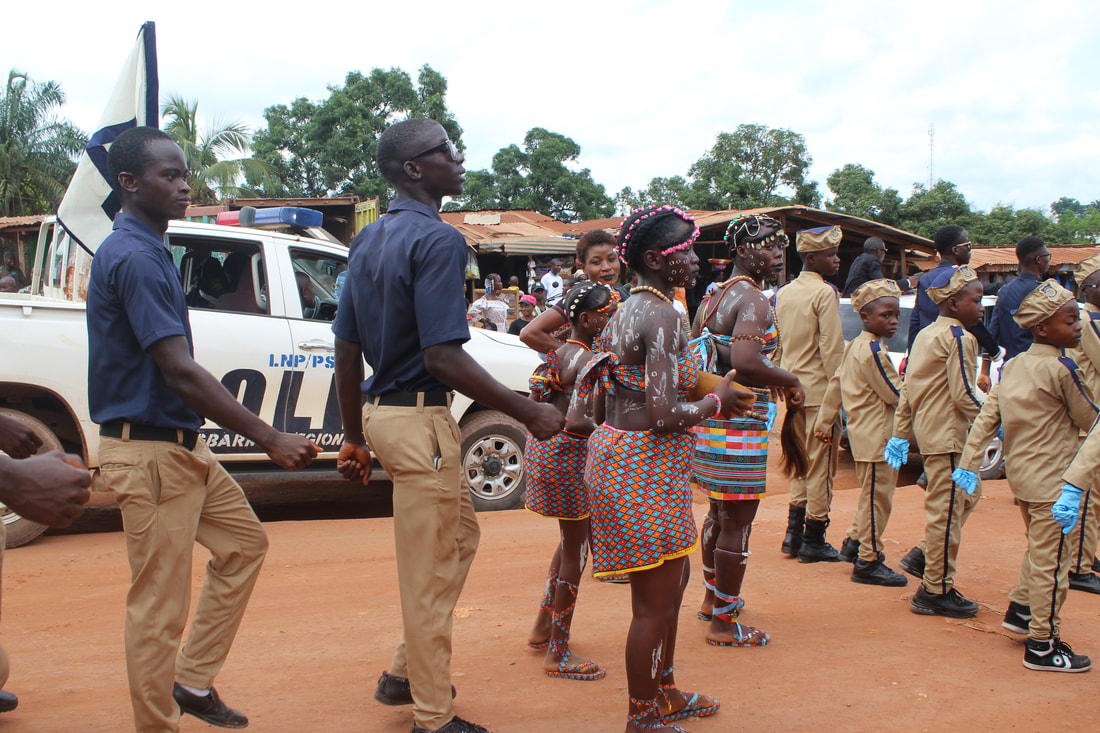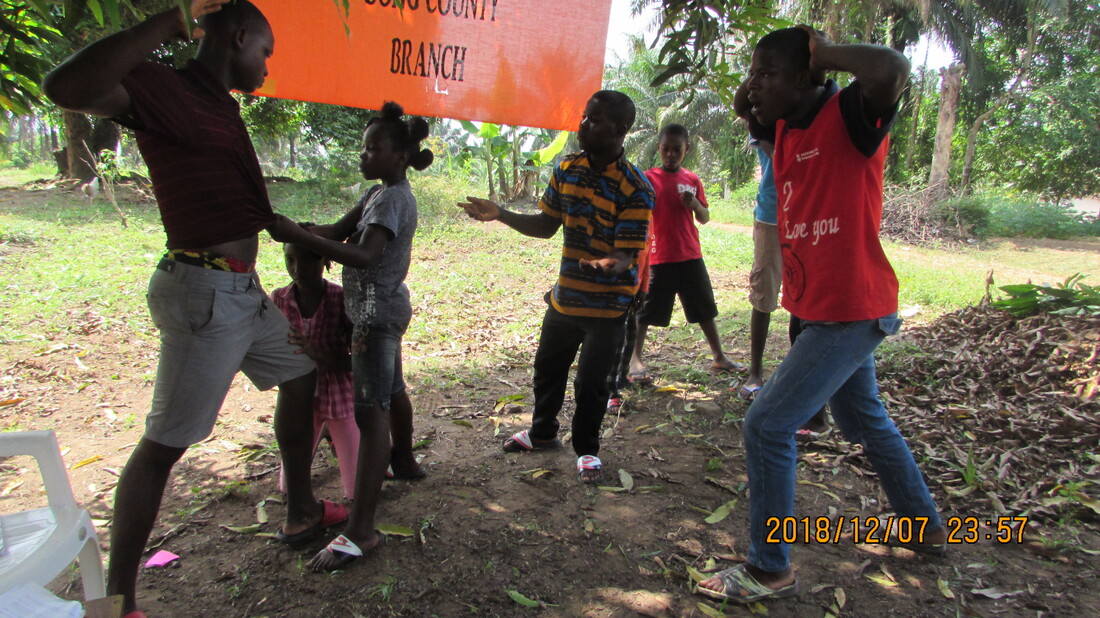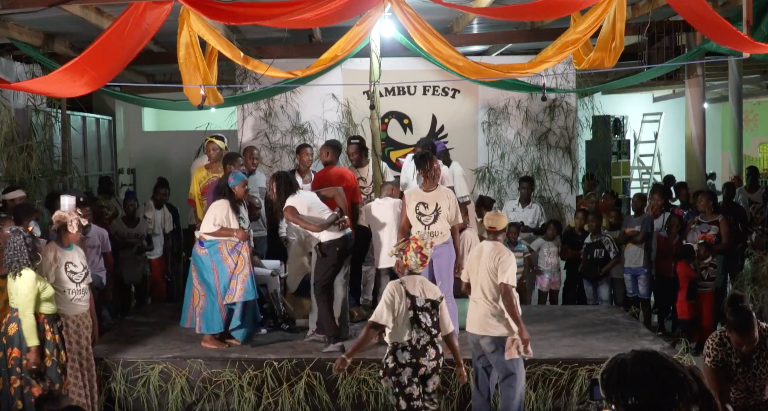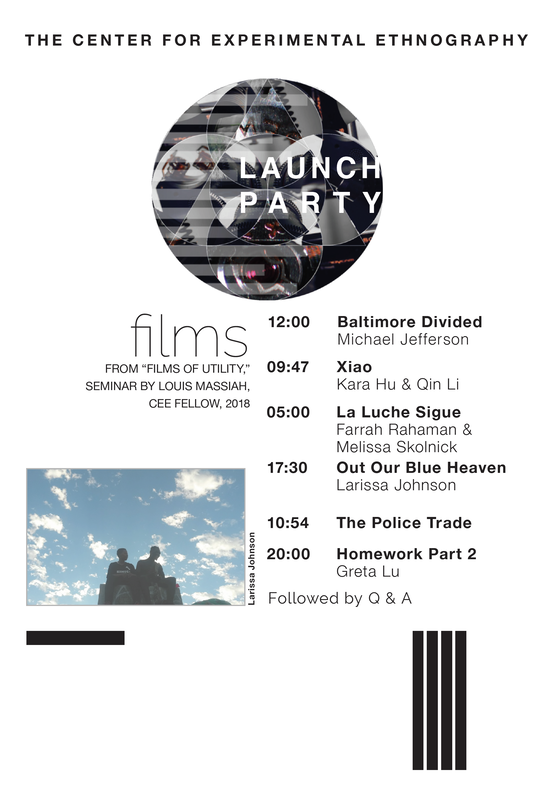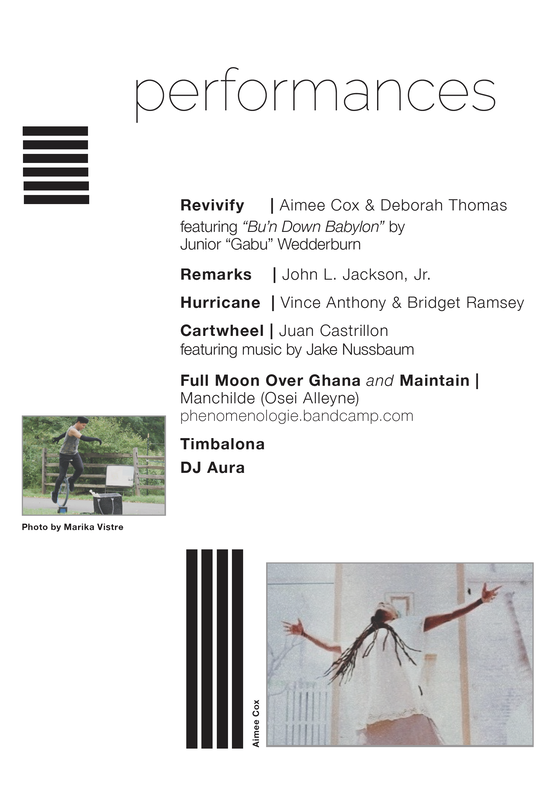CEE | Center for Experimental Ethnography
Menu
CONVERSATIONS
A blog of the Center for Experimental Ethnography
|
The eight-day Performance Intensive held in Philadelphia between January 5th and January 12, 2020 included public performances and a public lecture offered by three visiting artists, taisha paggett, Wilmer Wilson IV and Jibz Cameron (aka Dynasty Handbag) and one visiting scholar, Tavia Nyong’o, workshops led by Sharon Hayes, Weitzman School of Design and Brooke O’Harra, School of Arts and Sciences and the development and presentation of “proposals” by the 18 emerging artists who participated in the Intensive. The Center for Experimental Ethnography was excited to help support travel for two of the selected artists, Gabriel Christian and Monilola Olayemi Ilupeju at the Performance Intensive (see below). 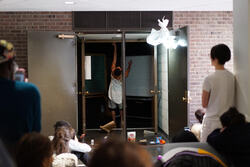 Gabriel Christian, proposal work, photo by Rå Vitche-Boul. Gabriel Christian, proposal work, photo by Rå Vitche-Boul.
Gabriel Christian, proposal work, photo by Rå Vitche-Boul. Gabriel Christian Gabriel Christian is an increasingly amorphous artist bred in New York City and baking in Oakland. Their work metabolizes the vernaculars within BlaQ diaspora –– futurity, afrovivalism, faggotry –– through body-based live performance and poetics.
Monilola Olayemi Ilupeju
Monilola is a transdisciplinary artist and writer living and working in Berlin. She graduated from New York University in 2018 where she studied Studio Art (Honors Studio) and Social and Cultural Analysis, the latter of which focused on the intersections of race and cultural studies, gender and sexuality studies, philosophy, sociology, and political science. The knowledge acquired in these fields continues to inform her practice today. She is also an alumna of the Skowhegan School of Painting and Sculpture Class of 2018.
0 Comments
The Performance Intensive was an eight-day performance laboratory structured around three primary activities: public performances and a public lecture offered by three visiting artists, taisha paggett, Wilmer Wilson IV and Jibz Cameron (aka Dynasty Handbag) and one visiting scholar, Tavia Nyong’o, workshops led by Sharon Hayes, Weitzman School of Design and Brooke O’Harra, School of Arts and Sciences and the development and presentation of “proposals” by the 18 emerging artists who participated in the Intensive. These 18 participants were selected through a nomination and application process. We had three MFA students from Penn, three PhD students from Penn, one from Communications, one from English, one from Music. There were three local Philly artists and then 9 out-of-town artists, from Boston, from Oakland, from Berlin, from Virginia, from New York. The Performance Intensive was committed to fulfilling three primary aims: One was to allow emerging artists working with performance, across different genres, to come together and learn from each other. The second was to provide a temporal frame for learning, exploring and experimenting that allows for longer and more sustained time than that of a class period. The third was to seed the beginnings of an infrastructure for engaged, in-depth innovative research in performance praxis.
The Performance Intensive is a model that may continue, but also one that can serve as a magnet to attract relationships with other scholars and practitioners across different schools at Penn and beyond who are interested in elevating performance as a praxis and a site of research. Performance Intensive Participants This list includes 3 PhD students from Penn (one each from English, Communication and Music), 3 MFA students, 3 local Philadelphia artists (one of whom is a Penn alum) and nine from outside of Philadelphia. Of those 9 out-of-town artists, CEE supported travel stipends for two: Monilola Olayemi Ilupeju, based in Berlin, and Gabriel Christian, based in Oakland, CA. Short bios for those artists follow the participant list below. Bashezo Jordan Baum Gabriel Christian Julia Gladstone Monilola Olayemi Ilupeju Amber Rose Johnson Larissa Johnson Mia Kang Nick Moncy Malcolm Peacock Gabby Preston Guava Rhee Emmanuela Soria Ruiz Kristine Rumman Noemi Charlotte Thieves Erik Thurmond Roopa Vasudevan Alex Velozo Emily Carris began her presentation posing a question she first asked during her studies in photography in England, while contemplating an image of a slave ship in a tumultuous ocean.... "what does salt know?" Seven years later, Emily returned to Philadelphia where she contemplated the possibilities of a space that joined art production, research, and community intervention, eventually founding the Art Dept. Collective in Fishtown, Philadelphia. In her own art practice, Emily began intensively researching the medium and materiality of dyes, textiles, fibres, and medicines in her work with archival portraiture and imagery of enslaved persons. In a memorable example, Emily described how she worked to craft an iron dye by submerging antique slave shackles in alcohol where they slowly dissolve. Engaging with Black women’s traditions of quilting, textile work, and healing, one of Emily’s most exhibited pieces features indigo and silk matta root embroidered over the raised whip scars on a famous portrait of “Peter,” an enslaved man who escaped from a Louisiana plantation in 1868. She is following this interest in textiles and quilting to explore the concept of armor as clothing, and the powerful historical intersections of quilting and warrior culture. Following Emily Carris's presentation, dr. Prof. Wayne Modest began by introducing his current project as the Director of the Research Center for Material Culture (RCMC). The RCMC is ann integrated center for research into ethnographic collections in the Netherlands exploring the meanings, political histories, and material flows that objects in these collections raise. He began his talk with an insightful provocation: “What happens to a history of design if we look outside the West...or teach a history of photography starting in 1842 in Jamaica rather than one starting in 1839 in Europe?” Pointing to the other histories that remain to be written, and the voices that remain to speak, Wayne argued that ethnographic objects in these collections carry within them ways of thinking history and write history otherwise. Museums can choose to draw attention to these revolutionary potentials, and in so doing call attention to, and work to un-silence, the systematic muting of the colonial violence and harm that these collections often emerged out of. Wayne highlighted the importance of asking, rather than just assuming, whether or not museums as “salvage” institutions borne out of the colonial projects driving people’s to extinction in the first place, can be or should be repaired
by Patrick Ammerman 2019 Pulitzer Center Student Fellow Graduate Student, Social Work Multimodal notes from fieldwork supported by the 2018-2019 Multimodal Summer Research Grant at CEE.
Youth as "Civic Actors" For Policy and Practice in Liberia by Jasmine Blanks Jones PhD Candidate, UPENN Graduate School of Education and Department of Africana Studies Multimodal notes from fieldwork supported by the 2018-2019 Multimodal Summer Research Grant at CEE. This study centers young people’s collective efforts to shape policies and practices that impact the wellness of their communities through the performing arts by engaging with a youth theatre company in Liberia that I founded in 2010 alongside of several Liberian advocacy organizations that utilize drama as a primary method to disseminate awareness messaging and collect data for policy change and public health initiatives. The content of these performances is rooted in social, economic and political factors that impact the quality of life and future aspirations of the young people who are centered in this study. The project focuses on physical gestures and highlights the “multiplicity of responses and interpretations of theater performances” which reveal “the relationship between performance and nationalism… and struggles for power between and among citizens and states” (Covington-Ward, 2015, p. 23) to investigate three questions: 1) How are young people leveraging cultural production to advocate for alternatives to policies and practices impacting their wellbeing as emerging citizens? 2) In what ways do the performing arts create possibilities for collective work towards a shared project, and how are artists’ projects made possible or constrained by the development agendas of donor organizations? 3) How can performance ethnography be used with youth to add authority to their civic practices? While participant observation may allow the researcher to navigate between outsider and insider status (Creswell & Poth, 2017), in my aim to understand the embodied meanings of citizenship, I draw on the work of Conquergood and Turner and engage in co-performance: “The power dynamic of the research situation changes when the ethnographer moves from the gaze of the distanced and detached observer to the intimate involvement and engagement of ‘coactivity’ or co-performance with historically situated, named, ‘unique individuals’” (Conquergood, 1991, p.189). Rehearsals will be captured by video and analyzed for gestures that invoke social hierarchies (Conquergood, 2002); video clips will be viewed and discussed in focus groups using the event-recall-feedback method designed for research with Liberian musicians (Stone & Stone, 1981). Through this study, I hope to lift the potential of dramatic performance as a key indicator of youth civic engagement with implications for policy and practice.
Heritage and Oral Histories at the Mine of Death in Santa Bárbara, Peru. by Charlotte Williams Graduate Student (UPENN Dept of Anthropology) Multimodal notes from fieldwork supported by the 2018-2019 Multimodal Summer Research Grant at CEE. Kumina as Embodied Archive Multimodal notes from fieldwork supported by the Center for Experimental Ethnography. This summer, three graduate students accompanied professor Deborah A. Thomas to Jamaica to participate in the second annual Tambufest, in the parish of St. Thomas. Tambufest, organized by Junior “Gabu” Wedderburn (one of Thomas’s collaborators on “Tivoli Stories” and Bad Friday), is a celebration of one of Jamaica’s most vibrant and dynamic traditions – Kumina. Kumina was developed by members of the self-described Bongo Nation in eastern Jamaica, the area that has led the resistance to colonialism, that birthed the Morant Bay Rebellion and inspired the founding father of the movement of. Rastafari, Leonard Howell. Though geographically dispersed, particularly across the parish of St. Thomas, members of the Bongo Nation looked to the Congo-Angola and Guinea Coast regions of Africa as the home of their oldest ancestors. They found in the tradition of Kumina a unifying cultural heritage, one that interweaves musical, linguistic, movement, and spiritual practices that connect them to the ancestors. Kumina is, therefore, an embodied archive of our history. It is also the tradition that is at the root of the popular music of dancehall and reggae. This year, Tambufest began by honoring the elders who have served the tradition over their lifetimes. This was followed by poetry readings, a performance by the Kingston Drummers, and drumming and singing (and dancing!) by the St. Thomas Kumina Collective, a group that brings together representatives of all the St. Thomas Kumina groups. The whole event was recorded by Alain van Achte (sound engineer for Broadway’s The Lion King), and was broadcast live through internet radio by Jake Nussbaum, a graduate student in the Department of Anthropology who is pursuing the CEE Graduate Certificate. The event was documented on film by graduate students Dee Asaah (Graduate School of Education) and Farrah Rahaman (Annenberg School for Communications), and Farrah will edit the footage into a number of short clips, and a short film that will also serve as archival material for the community of practitioners. "Broadcasting Tambufest is an opportunity to amplify kumina’s affective, spiritual, and political dimensions, and to think about how creative practices can move through time and space beyond their immediate public.”---Jake Nussbaum, Graduate Student (Dept. of Anthropology) "The Tambufest is an invaluable celebration of timeless cultures. What a sight to behold elders, youth, and even young children from different communities across Jamaica engaging with passion in music and dance! The festival's intergenerationality is particularly poignant, strengthening communal ties through nurturing and propagating the magic of Kumina." Tambufest is part of a broader project, “Bush Music,” which is ultimately meant to amplify awareness of traditional musical practices associated with Afro-Jamaican rituals – such as Kumina, Nyabinghi, and Coromantee – through digital archiving and collaboration with ritual practitioners. On one hand, Wedderburn seeks to preserve the integrity of the original forms, understanding that people constantly innovate based on current experiences, the availability of other instruments, and familiarity with drumming traditions from other parts of the Caribbean and Africa. More broadly, Tambufest seeks to create dialogical spaces within Jamaica and beyond within which communities might discuss the forms of renewal and respect they would like to see moving forward. By embracing that which has been denigrated – “bush” music – we want to re-enchant humanistic practice in a way that could reformulate the grounds of modernity, both within the artistic sphere and more broadly. Watch some short clips from Tambufest 2019 below! Step into the Opening Rituals of the 2019 Screening Scholarship Media Festival at the University of Pennsylvania, a CAMRA-organized festival supported in part by the Center for Experimental Ethnography. This year's opening features a collaborative, interactive ritual performance with Aimee Cox (Center for Experimental Ethnography Faculty Fellow 2019), Saya Woolfalk (New York) and Daniel Alexander (Mellon Foundation Creative Research Fellow at the University of Washington ) and coordinated by Aishah Shahidah Simmons. The artists discussed their process during a panel the following day. They addressed issues related to improvisation, and questions of spirituality and identity, movement and mobility.
The Screening Scholarship Media Festival (SSMF) provides a creative, collaborative space to explore the affordances and challenges of multimodal strategies in research, and to interrogate their social implications. SSMF is a hybrid between a traditional academic conference and a film/media festival. The 2019 SSMF features works rendering matters of concern and the present histories of: Indigenous people; Persons under any form of detention; Diasporic communities; LGBTQ+ collectives; and environments in conflict. The Center’s official launch party was held on February 15th, 2019. It began in Widener Auditorium at the Penn Museum with the screenings of student films from CEE Faculty Fellow Louis Massiah’s class, "Films of Utility." Massiah is the founder and director of Scribe Video Center in Philadelphia. He is an award-winning documentary filmmaker whose innovative approach to documentary filmmaking and community media have earned him numerous honors, including a MacArthur Fellowship “genius” grant, 1996-2001, two Rockefeller/Tribeca fellowships, and a Pew Fellowship in the Arts. In addition to his many film honors, he was recently charged with creating the film archive for the new Musée des Civilisations Noirs in Dakar, Senegal. The launch party then moved to the Upper Egypt gallery for a reception and performances. These performances included a duet by Aimee Cox and Director Deborah Thomas; a performance of the newly released song “Hurricane,” by Vince Anthony (more on him below) and Bridget Ramsey; a bit of juggling by graduate student Juan Castrillon (Music), accompanied on drums by graduate student Jake Nussbaum (Anthropology); some spoken word and rap by former graduate student Osei Alleyne (Anthropology, now at University of the Arts); a rumba band, and a DJ. You can view a “trailer” of the performances here. PROGRAMThe Center supports course development, and this year we offered a grant to Guthrie
Ramsey’s upper level seminar “The Music Industry Meets Activism,” an interactive course that explores the relationship between the popular music industry and the sound-worlds it comes from and returns to. It places the business of music in dialogue with various forms of historical and contemporary activism with an emphasis on Philadelphia. Through case studies, students learn how the industry generates and manages its various revenue streams. Students also witness how music can operate as a living activity that galvanizes and creates community and social bonds through industry and on-the-ground local networks. In addition to readings and discussion, students visited two performance venues, had several in- class visits from artists and industry professionals, organized a performance, and most important, engaged with an artist-in-residence (Vince Anthony), a local singer/songwriter/ producer who attended every class. As students learned about the functions of a management team and record label, they acted as a team to write press kits, develop artistic statements, build a social media campaign, plan and execute a music video shoot, and understand the role of contemporary radio in music promotion. Students also visited, interacted with, and learned about four local activist organizations: the Philadelphia Clef Club of Jazz and Performing Arts, OURchive, the One Art Community Center, and Musiqology Rx. Students reported that they enjoyed learning about the music industry from many angles—theoretically, practically and historically, and that they had been particularly excited to interact with living artists and producers who shared their insights from their varied perspectives. The artists reported that they felt it was invaluable to have been exposed to academic discussions each week, because it afforded them a type of discourse and focus that they find hard to come by in the daily grind of hustling resources to make and market their art. Listen to more of Vince Anthony's works on Soundcloud. Learn more about Prof. Guthrie Ramsey's work in the Department of Music. |
Contact Us // 438 PENN MUSEUm // experimental-ethno@upenn.edu
© 2018 The Trustees of the University of Pennsylvania
